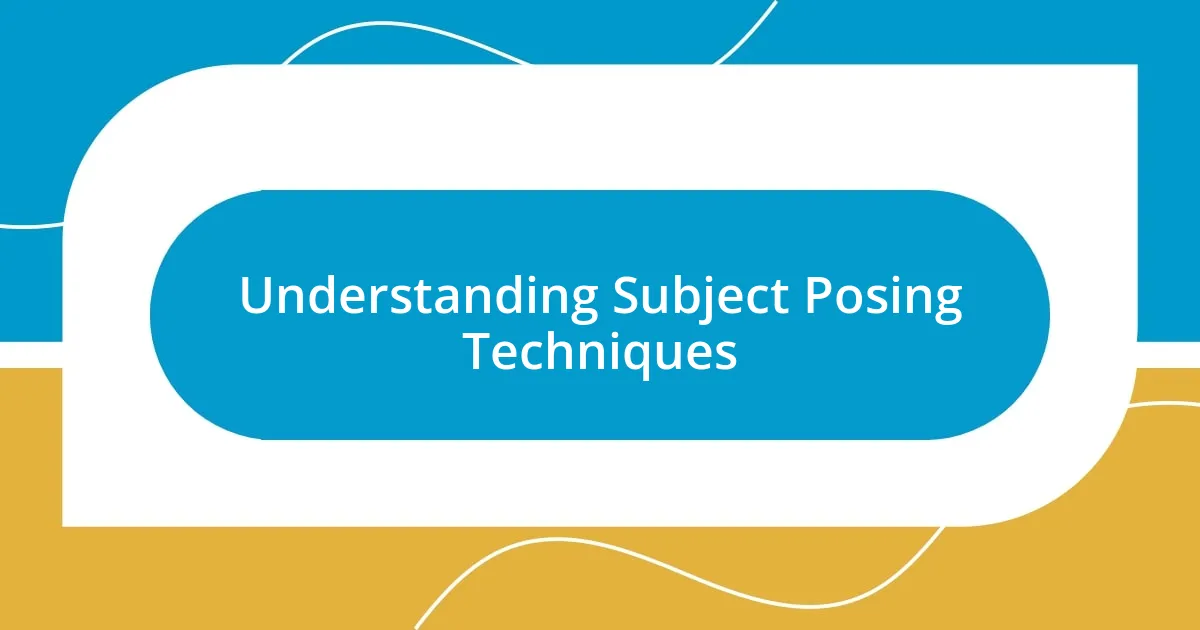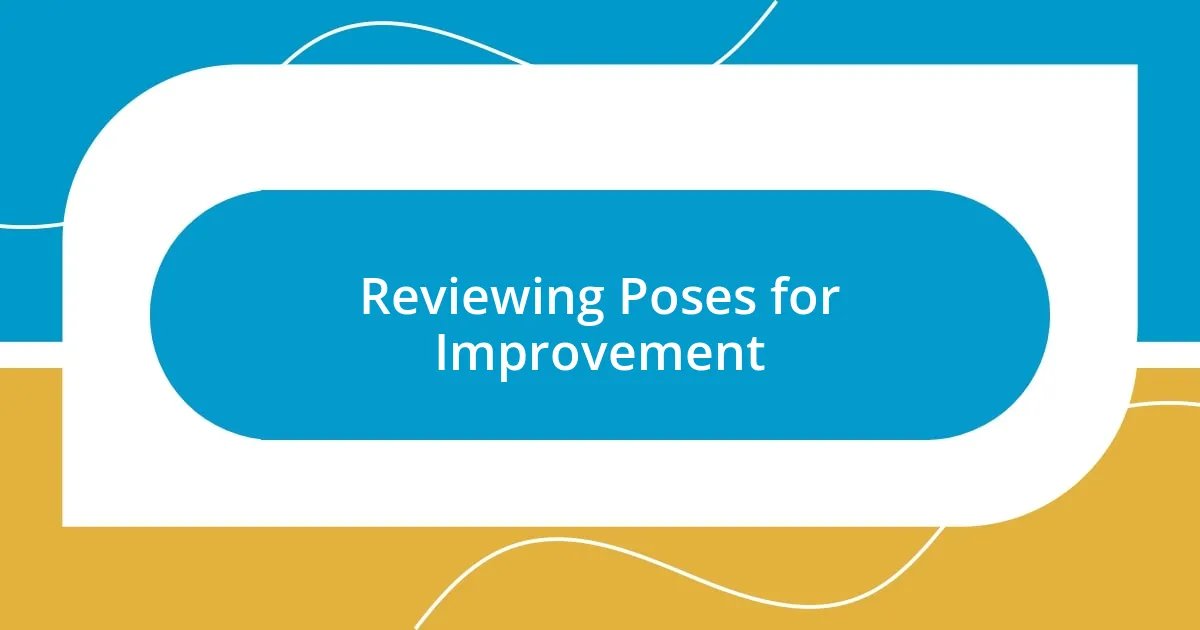Key takeaways:
- Creating a connection and comfort with subjects enhances their expressions and confidence during photoshoots.
- Dynamic posing benefits from movement, varied angles, and authentic expressions that reflect the subject’s personality.
- Adapting poses based on the setting and lighting significantly impacts the emotional tone of the images.
- Reviewing and reflecting on past poses helps improve skills and reveals what works best for conveying emotions in photography.

Understanding Subject Posing Techniques
When I first started practicing posing techniques, I quickly understood that it’s all about creating a connection between the subject and the camera. I remember a shoot where the model seemed stiff; it hit me that making them feel comfortable could transform their whole demeanor. Have you ever considered how a subject’s expression changes when they’re genuinely engaged?
Finding the right angles is crucial for effective posing. I once worked with a client who insisted they were camera-shy, yet with a little guidance on tilting their chin and shifting their weight, their transformation was remarkable. This experience taught me that subtle adjustments can not only enhance a subject’s confidence but also reveal a more authentic version of themselves.
In my opinion, mastering subject posing techniques requires not only technical knowledge but also a sense of empathy. When I discuss poses with my subjects, I often ask them what feels natural to them—this two-way dialogue brings out a relaxed energy that’s palpable in the final images. Have you ever noticed how personal comfort and openness can elevate a photo from good to truly captivating?

Essential Elements of Effective Posing
Effective posing hinges on several essential elements that elevate the quality of your photos. One of the most significant factors is the subject’s comfort level. I recall a time during a family photoshoot where the kids were restless and uncooperative. Instead of pushing them into stiff poses, I engaged them with a playful dialogue about their favorite games. The result? Genuine smiles and dynamic, candid shots that truly captured their personalities.
Here are some key elements to consider for effective posing:
- Connection: Create a rapport with your subject to ease tension.
- Angles: Experiment with different angles; they can reveal the subject’s personality.
- Movement: Encourage slight movements to avoid a rigid look.
- Expressions: Direct and evoke emotions for more authentic expressions.
- Body Language: Guide them on how to position their arms and legs to convey confidence.
By integrating these elements, you enhance not only the subject’s experience but also the overall impact of your images.

Tips for Communicating with Subjects
Effective communication with your subjects is critical in fostering a comfortable environment that can lead to stunning portraits. For instance, during a recent engagement shoot, I noticed the couple seemed a bit nervous. I took a moment to share a lighthearted story about my own engagement, which prompted them to relax and reveal their personalities naturally. This moment reminded me that building trust can often create a bridge to more authentic expressions.
It’s also important to be directive yet flexible in your communication. There was a time I worked with a group—an energetic bunch of friends—and instead of merely positioning them, I encouraged them to interact. I prompted them to share funny stories about one another. As they laughed, the dynamics changed, and their joyful energy translated beautifully into the photographs. Think about how often laughter and genuine connection can alter the feel of your images.
Lastly, as a photographer, I find it essential to actively listen. I recall a particular photoshoot where I focused intently on what my subjects wanted out of the experience. They expressed a desire for candid shots, and by shifting my approach from posed to capturing genuine moments, I was able to create a series of images that truly reflected their love story. Listening to your subjects not only shows that you care but also helps you to deliver what they truly envision.
| Communication Techniques | Benefits |
|---|---|
| Sharing personal anecdotes | Builds rapport and eases tension |
| Encouraging interaction | Creates dynamic, authentic expressions |
| Active listening | Meets subjects’ expectations and desires |

Creating Dynamic Poses for Impact
Creating dynamic poses is all about harnessing energy and movement. I remember a fashion shoot where I asked the model to sway gently as she posed. This simple request turned a static shot into a vibrant image filled with life, just from a little shift in her weight. It’s amazing how even slight movements can completely change the dynamics of the photo—don’t underestimate the power of motion!
Playing with angles can also add intensity to your shots. On one occasion, I decided to shoot from a lower angle during a portrait session. The subject appeared taller and more confident, which enhanced the overall impact of the image. Think about it: how does your perspective change what you see? By varying your viewpoint, you can uncover unique aspects of your subjects that might be missed from a traditional eye-level angle.
Lastly, expressions play a pivotal role in creating impactful poses. During a candid shoot with friends, I asked them to recall their most embarrassing moments. Their laughter brought out authentic joy, resulting in photographs that were not just visually striking, but also rich with emotion. Isn’t it refreshing to capture those genuine moments instead of forced smiles? Engaging your subjects emotionally opens the door to spontaneity and creates a stunning narrative in your images.

Adjusting Poses for Different Settings
Adjusting poses for different settings can dramatically transform the emotional vibe of your photographs. For instance, I once found myself shooting in a vibrant urban environment, full of life and energy. Instead of standard poses, I encouraged my subjects to reflect their surroundings. They leaned against colorful murals and interacted playfully with the gritty backdrop, which infused a sense of spontaneity and authenticity into the images. Isn’t it fascinating how the setting can influence the mood of the shot?
When I worked in a serene, natural setting, like a quiet beach at sunset, I shifted my approach entirely. I instructed my subjects to mirror the gentle waves and soft hues of their surroundings. I suggested they walk along the shoreline hand-in-hand, allowing the calmness of the ocean to guide their interactions. By adapting their poses to align with the peaceful environment, the resulting images felt intimate and timeless. Doesn’t this technique create a deeper connection between the subjects and their setting?
Moreover, lighting plays a significant role in adjusting poses effectively. I recall a moment during a golden hour shoot in a sunflower field, where the warm, glowy light encouraged my subjects to lean into one another, drawing out genuine affection. I adjusted their poses to embrace that magical lighting—turning their bodies slightly to catch the sun and framing their lovely interactions. Have you ever considered how different light conditions can dictate the feelings your images convey? When I adapt poses based on surroundings and lighting, I consistently find that the end results not only resonate more with viewers but also tell a richer story.

Reviewing Poses for Improvement
Reviewing poses for improvement is a crucial step in refining your photography skills. After a recent session, I scrutinized a series of shots where I had my subject cross their arms. While the intention was to convey confidence, it unintentionally created a barrier. This experience reminded me that poses should feel natural—asking for feedback from the subject often helps reveal how they perceive their own body language. Isn’t it interesting how a slight shift in posture can alter the emotion conveyed in an image?
As I delved deeper into those images, I noticed some poses lacked energy. One shot featured a beautiful landscape, but my subject was too rigid. To remedy this, I started incorporating dynamic elements—like asking them to jump or dance within the frame. The difference was striking! Just that little extra movement transformed the composition from stilted to vibrant. It’s astonishing how engaging my subjects in the creative process not only improves the outcome but also brings an element of fun to the shoot, don’t you think?
Furthermore, consistently reviewing my work allows me to identify trends in what works and what doesn’t. During one critique session, I realized that poses with slight angles rather than symmetry often translated better emotionally. I now experiment with tilting heads or shifting shoulders to add depth. This has yielded striking results! Each review not only strengthens my understanding of effective posing but also reminds me that growth is a continuous journey fueled by reflection and adaptation. How do you approach your reviews? Engaging in this process can inspire you to evolve your style continuously.












